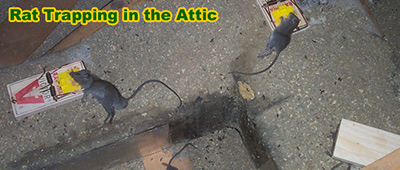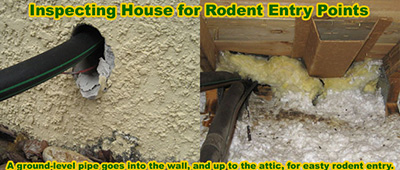I built this website as a resource for people who want to
get rid of a rat problem in a house. It's loaded with
information, and if you have rats in the architecture, like
in the attic or walls, your best bet is to just go to the
home page, and read the information there. The principles
for getting rats out of the attic are the same as for any
part of the home. The only exception is if the rats are
actually in the living area of the house - such as the
living room, bathroom, kitchen, etc.
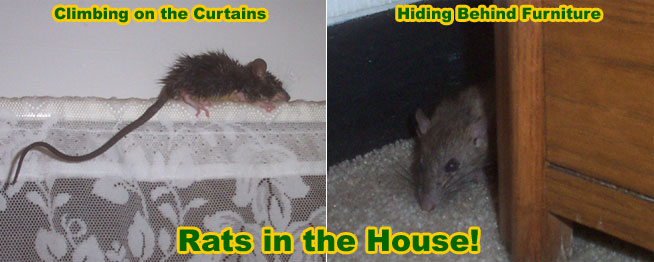
If you actually have rats inside the living area of the house, that's a problem! It's even worse than if they are living in the attic or walls, because inside the house itself, with people, they can spread disease, chew on your food, contaminate your food or property, chew on wires, chew on anything, basically. It's extremely unlikely that they would attack anyone, such as a sleeping baby, because rats are cowards, and they want to be left alone. But when everyone is in bed, yes, they can come out and mess with your stuff.
THE MOST IMPORTANT THING - FIND OUT HOW THEY ARE GETTING INTO THE HOUSE
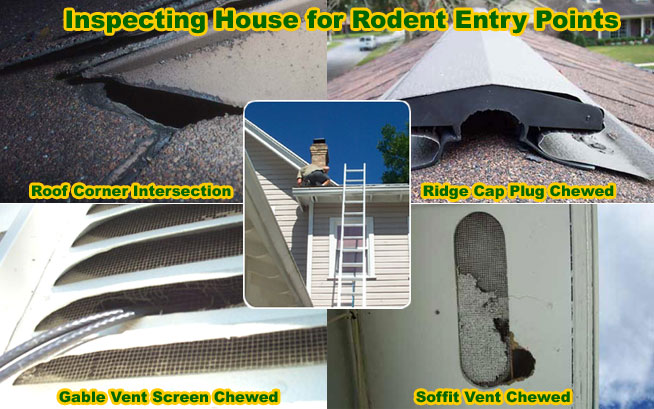
But what about how they are getting into the living space? Well, same thing - there are some openings that lead into the house. The power supply for the stove, which has a wire that goes into a wall and right up the wall into the attic is a good bet. I see lots of rats getting into the kitchen that way. Or maybe behind the washer/dryer? There could be several spots. Do a thorough hunt, and seal off any open areas with metal flashing, such as you see in the below photograph.
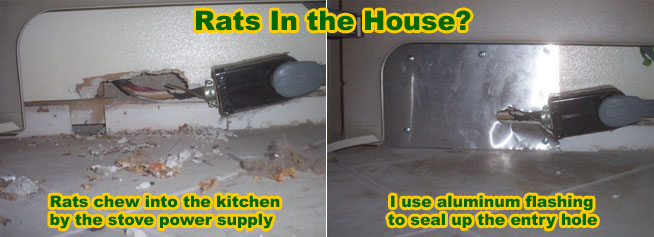
If you've got rats coming through the toilet then make sure that there are no breaches in your plumbing pipes, and that the water traps are full. Read here about rats in the sewer.
Killing rats in the house - Rats in the main are of a home are disturbing because they are in plain sight and are sharing your living space more intimately than a rat up in your attic. Rats are not particularly persnickety creatures and will live just about anywhere they feel is advantageous to finding food. If you have rats living in your home, make sure you eliminate access to anything that may be considered a food source for them. Exposed trash and unsealed food will only promote growth in the rat population no matter what your lethal trapping methods are. Not only do you need to eliminate the food source, you also need to eliminate access from the outside. Rats are ingenious when it comes to home invasion. They can enter in through pipes and drains; they do not necessarily need a hole in the foundation. Killing the rats once they are inside can be a challenge. Rats are smart and survive by being industrious. Trapping will mean knowing where to place the traps and what to avoid using. For rodents living in the main areas of the home—actually for rodents anywhere in the home—do not use poison. Any poisoned animals will crawl into a dark space somewhere in the home and die. This almost never happens in a convenient location. Bodies in the walls are even more difficult to remove than live rats! The best rat control comes from snap traps, not poison.
THE SAME APPLIES TO MICE
Read more articles about rats:
Do rats destroy insulation in an attic?
Do rats chew on wires? Why?
What can rats chew through?
Will a rat chew through the ceiling?
What does rat feces look like? Where is it found?
Is rat feces dangerous to touch or breathe?
What kind of damage do rats cause in an attic?
How do I clean rat feces out of the attic?

Rats aren't much to worry about outside. Some of us may not mind at all if we see a few scurrying around the park or even pop into the garden shed once in a while. But once they're inside the house itself with access to food, shelter, and warmth, they become a problem that's more difficult to deal with. Rats can carry diseases, leave contaminated feces and urine around the place, and chew through almost anything. Not the ideal housemate. You'll want to get rid of them as quickly as possible to prevent a full-scale infestation.
Signs of Habitation
Before you invest in pest control professionals or traps to lay yourself, make sure that it's rats you're dealing with. Here are a few things you can look for to make certain there's a rat nearby.
- An obvious sign is droppings. A rat's droppings are long and dark and around the size of a grain of rice. They can be distinguished from a mouse's droppings from their shape. Mice droppings are much smaller with pointed ends. Rat droppings will have blunt ends.
- Rats have a tendency to use the same route to get to places over and over again. Because of this, you may notice greasy marks along skirting boards or furniture where the rat has brushed against it.
- Rats are noisier than mice, and you can usually hear them pretty easily when they're scrabbling around your home.
Once you're sure that it's a rat sharing your home, you need to move quickly:
- Deep clean your home. This means getting rid of clutter to prevent them from both using them for hiding spots and shredding anything to make a nest. Make sure that any food waste or pet food is cleaned up and seal your food storage well. This will eliminate any opportunistic foraging.
- Rats are incredibly nimble at getting through openings. If they can't squeeze through, they can often gnaw the hole bigger. Make sure to seal up any openings, loose drains or vents, and inspect any holes in the wall that pipes enter through. Use the toughest material you can find, steel or cement if possible. While you're at it, check that no electrical cables are being chewed. This can be a potential fire hazard.
- Lay traps. Use a live trap to relocate the animal humanely and place the trap near the location with the most suspected activity. If you suspect there may be multiple rats in your property, call a pest control professional who will be able to eliminate the problem. Rats commonly make nests, and a live trap may only be successful in breaking up a family. If you are concerned with the animals' welfare as well as you're own, your best bet is to contact a reliable professional for help.


